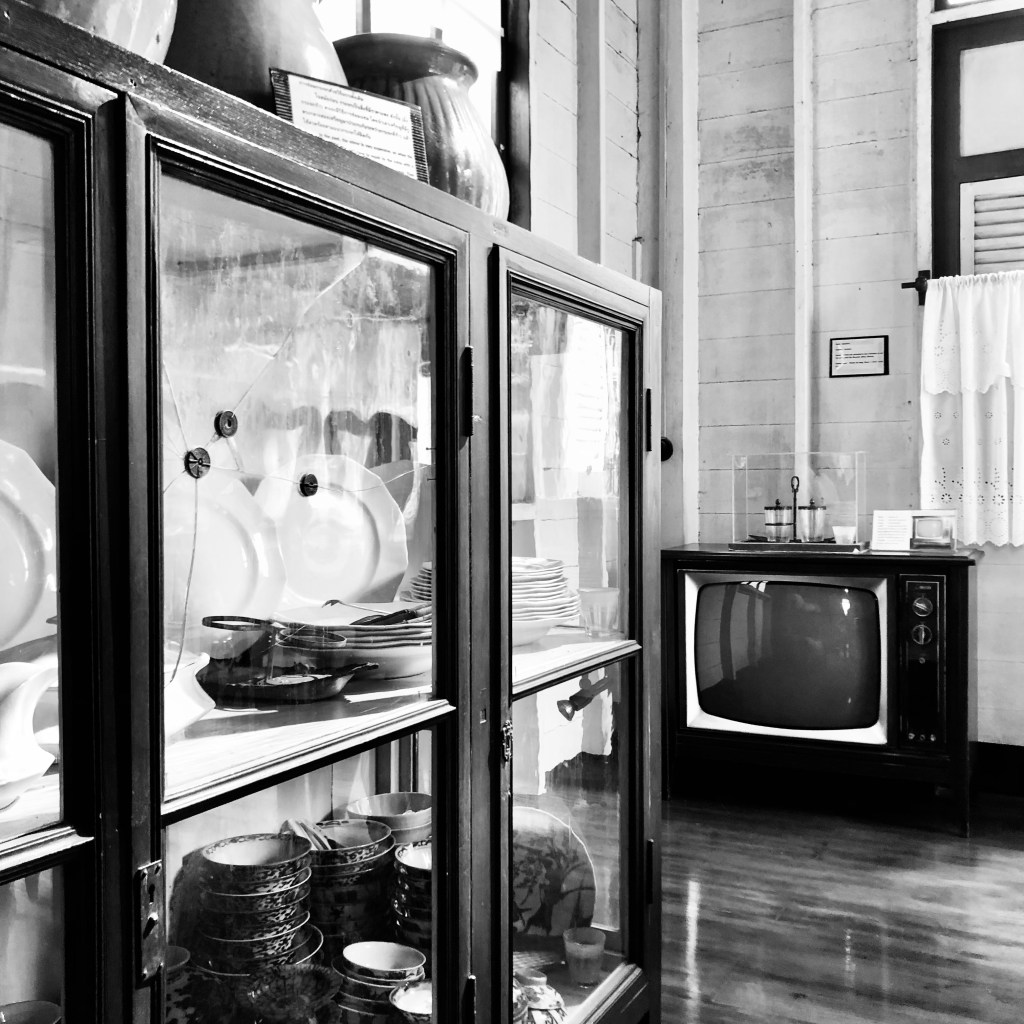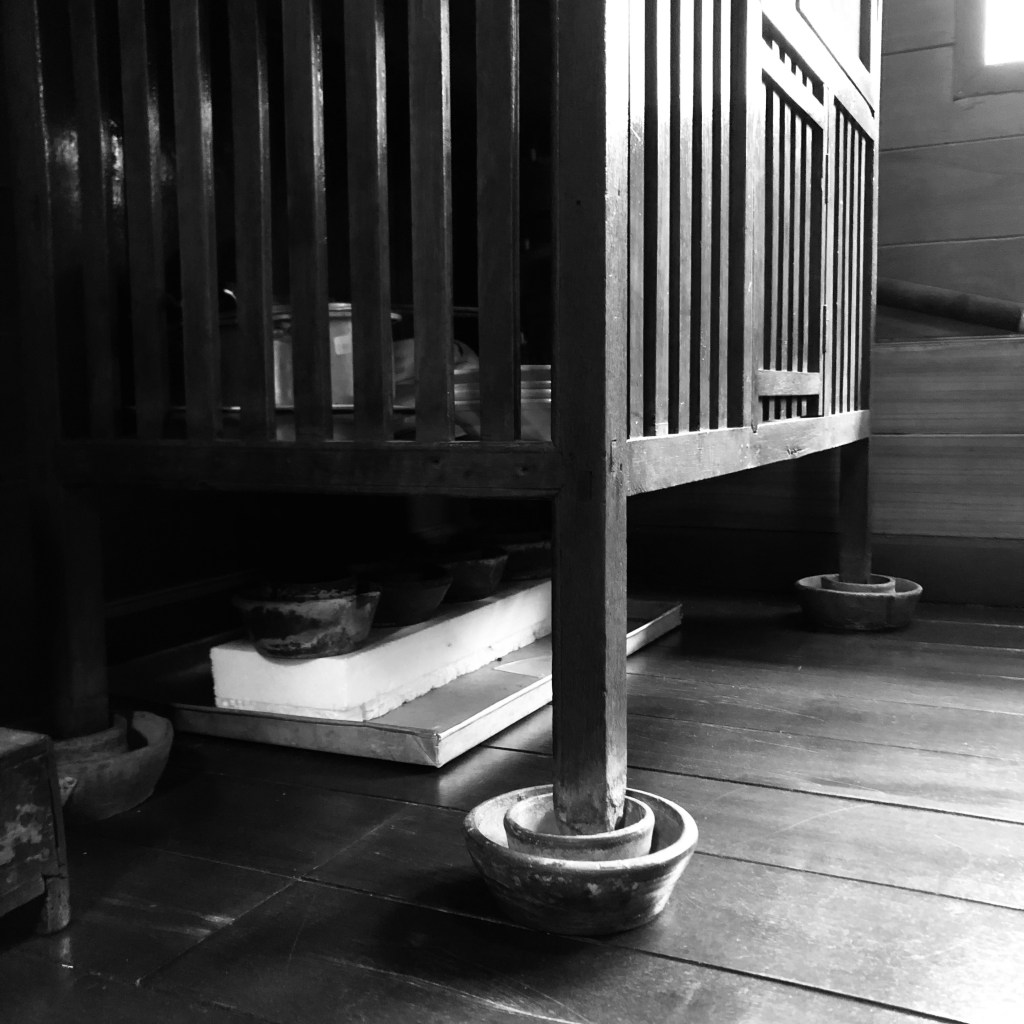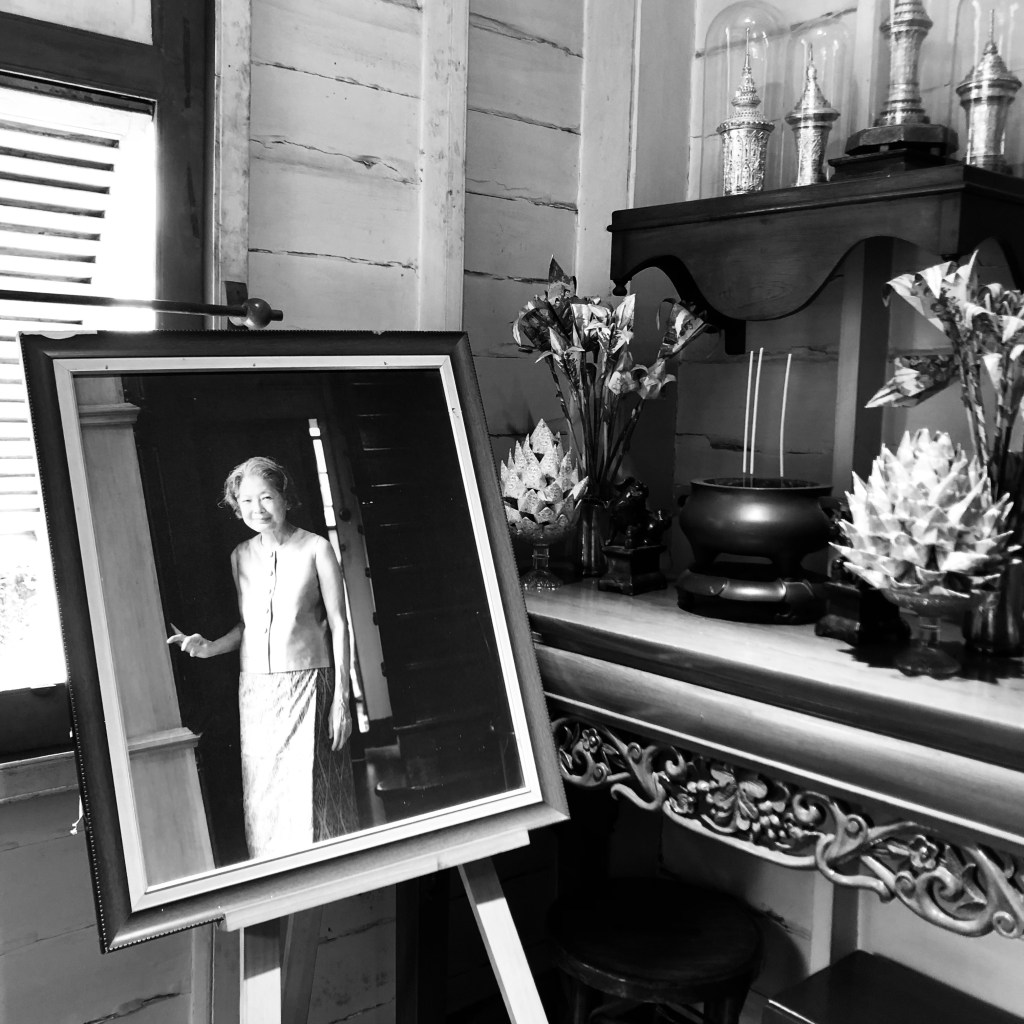Bangkok’s collective memory can seem shortsighted — increasingly blurred the further removed it is from its past. For many of us who live here today, it can be hard to imagine a time when the cityscape was not dominated by concrete, condominiums and highways, but rather, dotted throughout with wooden houses, low rise buildings and canals. It may be harder still, to believe that all the modernity, prosperity and urban sprawl that defines the city today, came into being largely during the last five decades. Perhaps that is why one woman’s family house-turned-museum in Bangkok’s Bang Rak district remains a quietly charming, yet powerfully compelling guardian of this city’s place heritage prior to and post-WWII.
When I moved to Bangkok over two decades ago, it quickly became apparent to me is that the story of this city, time and time again, is told through the lives of its prominent men and women — royals, aristocrats, tycoons and politicians. Larger than life individuals whose accomplishments and societal impacts are formed often by equal parts fact and folklore. Many of the city’s museums and institutions now reside in buildings that were once the elegant homes of these individuals and their illustrious families — some palatial in size and status. But what of the lives of the average, everyday man and woman? Over a decade ago I read an article that eventually lead me down a quiet street off of Charoenkrung Road where I found the story of one middle class family, lovingly told through a collection of ordinary items, weaving an evocative tale of daily life in Bangkok during the first half of the last century — housed in what is now appropriately named the Bangkokian Museum.
Situated on Charoenkrung Soi 43, the Bangkokian Museum consists of a cluster of three delightful wooden houses dating from the early 1900s, surrounded by a lush garden, including several ponds, as well as a row of midcentury shophouses forming what was once the family compound of Associate Professor Waraporn Surawadee, who inherited the estate from her mother, Sa-Arng Surawadee (formerly Tanboontek). Prof. Waraporn’s family, through her mother’s family line, have lived on this street for three generations from the days when it was known as Trok Saphan Yao (Long Bridge Lane), alluding to the structure that used to define the area, which was once crisscrossed by canals, long since paved over by roads. This family epitomised what in the early 1900s was the burgeoning educated, land owning, upwardly mobile Thai-Chinese merchant class that would in later years come to define Bangkok’s social landscape.




The Surawadee household was a large one characteristically defined by its strong women. In addition to Prof. Waraporn, her grandmother, her mother and her sister all worked in education.
“What you see here, this house, now a museum, is truly a product of circumstances” says Prof. Waraporn. “My mother married twice, first to Dr. Francis Christian, a British-Indian physician who had settled in Bangkok. Unfortunately he died at a young age not long after they were married and they had no children at the time. My mother inherited his modest estate. She then married my father Bumphun Surawadee and together they built this house in 1937 on a plot of land her family already owned.”
Born shortly after of the house was built, Prof. Waraporn lived on the property her entire life, along with with parents, her grandmother, her aunt and several siblings — a house not unlike that of Louisa May Alcott’s Little Women.
By the time Prof. Waraporn inherited the estate from her mother, she was the only surviving direct descendant. She was unmarried, with no children of her own. Rather than being content with enriching herself further from what her mother had left her, she self-engineered an idea to convert her family home into a museum to be shared with everyone — as a gift to all Bangkokians. Eventually Prof. Waraporn formally entrusted her family estate to the Bangkok Metropolitan Authority (BMA) on October 1st 2004, to be managed as a public museum with free admission, on the condition she could continue to live on the property (in a modest former guest house) for the remainder of her life.
Prof. Waraporn once said in a TV interview, “I didn’t want to sell the property. What would I do with all that money? All I’d have is just money. I wanted to do something in honour of my mother. I wanted to have the house survive intact for perpetuity. I didn’t need all the material items my mother had used and saved over the years. I’ve worked my entire life and I can live comfortably on my own means. I came to the understanding that what I had inherited as a whole, could be used for the greater public good.”
Over the years, I revisited the museum on numerous occasions and had the pleasure of being shown around the property by Prof. Waraporn herself, a woman small in stature, but with a commanding presence and an admirable command of English. The onetime owner turned tenant was a constant presence on every visit I made, and she was quick to correct anyone who still referred to the house as ‘hers’.
“It’s not mine anymore,” proclaims Prof. Waraporn, “it belongs to all of you. I’m just a volunteer, keeping busy taking care of the place and sharing my stories when I’m not working. I want to help keep telling the story of all these things because this was a real working house, filled with real working people — my family, it wasn’t just for show. We lived comfortably, we were happy here with these things.”
“You see, I come from a time and a generation where material possessions were harder to come by. Whatever we had, we had to take care of them. If it broke, we had to try our best to fix it — it was just what we did in those days. The idea of easily replacing things with something new just didn’t occur to us at the time. Things were made to last!”
“Some people think I’m a collector, but I’m not. These are all ordinary items found in many households. We simply threw away less things back then. Everything was valuable. We used things longer back then. Being someone who has taught my entire life, I wanted all these things my family acquired over the years to have a new life, to be used to educate people for generations to come on how we all used to live. Maybe there will be something they can learn from it, if they take the time to come and visit. I know they can learn from it.”
And what things indeed.
Within the three main structures that comprise the museum (two principle houses and a row of shophouses) are a treasure trove of everyday items largely dating from the 1930s through to the 50s. This was a period of tremendous changes in Thailand — the end of Thailand’s absolute monarchy, industrialisation and war, followed closely by the post-war economic boom.
Much of the Western style furniture dates from the time of Dr. Francis, lovingly kept and used by Prof. Waraporn’s mother through the years. She inherited all his belongings, including his medical equipment, many dozens of books related to medical studies, diaries, letters and other memorabilia.
“My mother kept all his [Dr. Francis] things in several large trunks. For decades all these things sat untouched, and protected. Even daily items like shaving kits, branded tins of Dr. Francis’ favourite food items, all survived intact, in the condition you see today,” noted Prof. Waraporn.
Throughout the main two-storey, seven room house, you see a convergence of tastes, technologies, and lifestyles. Where in one room you may see a betel nut chewing set with it’s accompanying spittoon, once belonging to Prof. Waraporn’s grandmother, alongside it is a distinctly Western style dressing table with perfume bottles and cosmetics. Thai style Bencharong bowls are showcased with European crystal, Persian ceramics and Chinese porcelain. Although upstairs the main house had a Western style bathroom with indoor plumbing, adjacent to the shower are several large cistern jars used for Thai style manual bathing. Downstairs there is smaller bathroom with no plumbing, modestly outfitted with removable enamelled tin ‘bowls’ set underneath wooden stools serving as toilet seats dating from the time when waste would be picked up regularly from house-to-house. by a cleaning company utilising horse drawn carriages.
The second two-storey house, is in fact the oldest, dating from 1929. It was intended as a small clinic for Dr. Francis with modest accommodation upstairs and was originally located on another plot of land in the Tung Maha Mek area (Sathorn) of Bangkok. Following the doctor’s untimely death, Prof. Waraporn’s mother decided to move the structure (which like the main house was built of teak without nails and designed like many structures of that era, to be easily dismantled when necessary) to its present location. Many of Dr. Francis’ personal items and professional equipment are now displayed in this building.






The row of modest shophouses once rented out by the Surawadee family to various business tenants, have now been converted into one uniform space housing one of the most comprehensive collections of middle class items to be found anywhere in Bangkok. No item was considered too small or too insignificant to be included. Cooking utensils, sewing kits, writing instruments, report cards, commemorative memorabilia, calendars, tools, gardening items, clothing, toys, all used by generations of Prof. Waraporn’s family and thankfully not thrown away. Everyone I have ever taken to the Bangkokian museum can’t help but smile and see things they, or their parents, or their grandparents once owned.
“We were lucky, we had space to keep all these things. I admit, we kept a lot of things, but they were all used and well loved for years and years. Some people might think we were rich, but really we were not. We all worked hard and we valued all these things we worked for. Nothing here is really all that special, what is special is that they all survived and that they all were used by my family in this very location. That’s what I want people to understand. Even normal people, normal lives, normal items, can have value if you give them that value. That’s the lesson I’m trying to teach,” says Prof. Waraporn.
The upper floor of the shophouses has been set aside to display a history of the Bang Rak area in which the house is located in. Aside from Bangkok’s the old town area of Rattanakosin, the Bang Rak area has born witness to so many of Bangkok and thereby Thailand’s historic ‘firsts’. The first modern road, the first foreign missions, the first bank, the post office, the first modern flats, the first hotel, the first department stores, the first tram line. The list goes on and on, and all of it within walking distance of this elegant, but unassuming family home.
“I was happy here. It used to be my home. Now it’s everybody’s home,” says Prof. Waraporn.
You might think that bequeathing her family home to the city was enough. That the joy she clearly received from being the custodian of this heritage was sufficient for Prof. Waraporn. Well, you would be wrong.
In early 2016, the long empty plot of land adjacent to the Bangkokian Museum came up for sale. Prof. Waraporn immediately expressed an interest in the small piece of land but was quickly rebuffed by the owner who said he had already found an interested buyer without any public bidding who agreed to purchase the land for just over THB 30 million. The buyer came from a family who is from the community who wanted to build a low rise mix-use residential commercial building. When construction was set to begin, Prof. Waraporn was astonished to find out that in fact a eight-storey commercial building was now to be built.
“I couldn’t believe it. I couldn’t allow this. I felt I had to do something,” Prof. Waraporn thought at the time.
Undaunted, what followed in the subsequent weeks was a truly remarkable crowdfunding campaign to secure a better future for the Bangkokian Museum, led by this semi-retired octogenarian who had already given much of her inheritance to the city she loved. Prof. Waraporn had long eyed the adjacent plot of land because she felt that the Bangkokian Museum’s biggest weakness was lack of parking. Museum attendance was largely pedestrian. If she could secure this plot, her vision would be to provided parking space as well as expanded community areas for education and public enjoyment.
Naturally, she reached out to the BMA, first to ascertain whether the construction of the eight storey building in this area was legal. In fact it was, due to a change in the zoning laws quietly approved in 2016, unknown to Prof. Waraporn and to the larger public as well. Second, if the construction of the site was legal, then the BMA should counter offer to buy the plot and enhance the Bangkokian Museum which by 2016 had already become overwhelmingly one of the most visited and popular of the 27 district museum managed by the BMA.
“They replied with silence,” lamented Prof. Waraporn. “I already gave the city my family estate worth in today’s money well over THB 100 million, this plot of land is small in comparison but its acquisition would be of huge benefit to the museum and the community. I knew I had to take matters into my own hands.”
Together with a team of volunteers, she offered to make a counter offer to the owners, who in the course of a few weeks now said the land with worth THB 50 million. Prof. Waraporn did not have that much money, what assets she did have was tied to the Insat-Sa-Ang and Dr Francis Christian Foundations which Prof. Waraporn herself had set up with money she had inherited, to honour her mother and her mother’s first husband. Through the foundation, Prof. Waraporn put THB 30 million towards the offer and negotiated down with the owner for a purchase price of THB 40 million. She was still THB 10 million short.
Not to be deterred, she had faith that she would be able to come up with the rest of the money required.
“I never had any doubt we could do it, it was only a question of how soon we could raise the money. I used the THB 30 million as a deposit, that would be forfeited if the rest of the amount could not be raised within 3 months,” said Prof. Waraporn.
Within days, she and her volunteers reached out to the press, the museum’s list of visitors, former students and colleagues, who in turn used the power of social media to spread the word. Thousands upon thousands of donations poured into a hastily set up account in the name of the two foundations. Prof. Waraporn tirelessly gave interview, after interview, took journalists on house tours, pleaded with the public to look into their hearts and give what they could if they believed buying this land for the museum was a worthy cause. She encouraged everyone who hadn’t yet been, to come to see for themselves what the museum was about. To see where she was born, where she grew up, and where she had devoted her life to, now for the benefit of everyone.
“People asked me why I didn’t appeal to any businesses or wealthy people for the money. I said this museum was given to the community. Its important the community has to be behind this initiative to acquire this piece of land, to have sense of grassroots ownership,’ Prof. Waraporn told press who had gathered at the museum in the initial days of the crowdfunding campaign.
In 10 days, thousands of small individual donations raised over THB 10 million. By August 2016 the acquisition of the adjacent piece of land was secured.
Prof. Waraporn was a woman of strong conviction who wouldn’t take no for an answer. Stubborn and resilient, an unexpected visionary who sought out to show that even at her age, she still had more to give.
“I know my story is unique. I don’t expect other older people to suddenly think their homes should be turned into museums too,” Prof. Waraporn says amusingly. “But I want people to see that old people, old things, old lives still have value, especially to the younger generation, who I hope can learn from us.
Prof. Waraporn passed away in January 2017, a less than half a year after successfully leading her land acquisition campaign. She died on the grounds of the Bangkokian Museum, her former home where she was born. Till her last days, she continue to fight for her legacy, now the heritage of every Bangkokian.
I recently revisited the museum in February 2023. All the familiar faces of the museum’s volunteers I had come to know over the years were still there. The museum was lovingly untouched by time, everything was just as it was. What had changed, was the adjacent plot of land. On it was the physical embodiment of Prof. Waraporn’s final wish, a multi-function communal space managed by the Insat-Sa-Ang and Dr Francis Christian Foundations — a brand new, recently completely structure called Ruen Waraporn (Waraporn’s House).

Bangkokian Museum
273 Charoenkrung Soi 43 (Saphan Yao Alley), Si Phraya, Bang Rak, Bangkok 10500
273 ซอย สะพานยาว แขวงสี่พระยา เขตบางรัก กรุงเทพมหานคร 10500
Bangkokian Museum is open 10am-4pm from Wednesday-Sunday. Admission is free. For more information call 02-233-7027 or 02-234-6741.
To get there, travel by car or bus No.1, 16, 35, 75 and 93. Surasak and Saphan Taksin BTS stations are both walking distance Fromm the museum. Parking is available.

Leave a comment